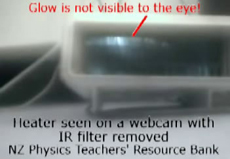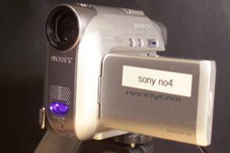Abstract
 Some webcams can be modified to extend its range further into the infrared. It can then “see” hot objects.
Some webcams can be modified to extend its range further into the infrared. It can then “see” hot objects.
This is one of three related demonstrations:
1) Near IR on a Camera: IR with wavelength slightly longer than visible light.
2) IR on a Modified Webcam: Extending the rage of the webcam.
3) Thermal Camera: Can see the “glow” of objects around room temperature.
Portable
Yes
Principles Illustrated
Infrared radiation, use of IR LEDs, transmission of infrared, electromagnetic spectrum.
NCEA & Science Curriculum
JNR SCI, SCI 1.3, PHYS 1.4, PHYS 2.3, PHYS 3.5, SCI 3.6,
Instructions
The near infrared resource shows how IR remote control lights are visible on most cell phone cameras, webcams, and other digital cameras. A webcam can be modified to extend its range further into the infrared by removing its infrared filter. The webcam can then “see” a warm heater filament glowing in the infrared that the eye cannot see glowing.
General instructions for modifying a webcam are available here.
Instructions for modifying the particular webcam we used:Â Modifying a Webcam.pdf
Note: Do not expect your modified webcam to give the crisp, sharp images it did before you hacked it apart!
Video of a heater on our modified webcam:
Download video (763 KB, right-click and save as): Heater.m4v

Some video cameras have a “night mode” that allows the camera to see into the IR and also includes an IR LED that illuminates the scene in front of the camera with IR light. We have found these cameras to be very useful!
Safety
Remember that the disassembled webcam will have a lot of small parts, and materials used in electronics are often toxic. Do not grind, sand, file, or otherwise damage electronic components.
Individual teachers are responsible for safety in their own classes. Even familiar demonstrations should be practised and safety-checked by individual teachers before they are used in a classroom.
Related Resources
Near Infrared on a Camera | Thermal Camera
Teaching Resources
Would you like to contribute lesson suggestions? Contact us.
Credits
This teaching resource was developed in collaboration with Rory O’Keeffe, a New Zealand Science, Mathematics and Technology Teacher Fellow, 2007, hosted by Victoria University School of Chemical and Physical Sciences. Rory is a science teacher by training and was Deputy Principal at Lytton High School in Gisborne, New Zealand. He is also an amateur astronomer. See NZSMT Teacher Fellowships for more information about the Teacher Fellow Programme.
This teaching resource was developed with support from
The MacDiarmid Institute
Faculty of Science, Victoria University of Wellington
School of Chemical and Physical Sciences, Victoria University of Wellington